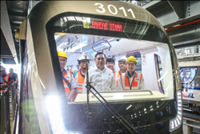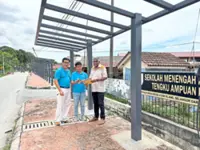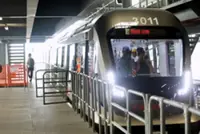PETALING JAYA: A new urban railway line with a capacity of up to 200,000 passengers daily will open next September to offer greater connectivity in the western part of the Klang Valley.
LRT3, now known as the Shah Alam line, has the ability to move 6,210 passengers per hour per direction (pphpd) to provide smoother travel for the 37km ride from Kampung Johan Setia, Klang, to Bandar Utama, Petaling Jaya.
The capacity of the line will be bumped up to 7,341 pphpd in early 2028 following the reinstatement of five stations for the line that were shelved by the government in 2018 due to cost-cutting measures.
Apart from the Bandar Botanik, Bukit Raja, Raja Muda, Temasya and Tropicana stations, the allocation given by the government includes the procurement of seven train sets and 150 electric buses, plus the construction of two depots to support the buses to enhance better connectivity for commuters.
ALSO READ: Revival of five LRT3 stations to cost additional RM5.3bil
In an interview leading up to the 20th anniversary of the Rapid KL brand, Prasarana Malaysia Bhd president and CEO Mohd Azharuddin Mat Sah said a slew of initiatives are being put in place to further drive public transport ridership, especially in the Klang Valley, with the commencement of the Shah Alam LRT by Sept 30, 2025.
Azharuddin also clarified that the actual cost of reinstating the five Shah Alam line stations was lower than the announced figure of RM5.3bil during the tabling of Budget 2025 last month.
“Out of the RM5.3bil allocation, RM1.1bil was payment for land that was already acquired for the project, so the cost for reinstating the five stations and associated infrastructure should be RM4.2bil.
“And it is not just reinstating five stations; the amount also covers the procurement of seven train sets and 150 electric buses, plus the construction of the depots to support the feeder bus service,” Azharuddin told The Star.
The fleet of electric buses was not part of the original plan but came in following a concerted effort by the government and its agencies to improve the first-and-last mile connections, which is one of the weakest links in public transport infrastructure.
“The Shah Alam LRT is more than 96% ready and will undergo testing and regulatory approvals by April next year,” Azharuddin said, adding that the five reinstated stations are expected to enter passenger service by early 2028.
The LRT line is managed by Rapid Rail Sdn Bhd, which together with the other Prasarana subsidiary, Rapid Bus Sdn Bhd, forms the core of Rapid KL, a branding introduced in November 2004 to provide a more integrated public transport system in the Klang Valley.
Rapid is the acronym for Rangkaian Pengangkutan Integrasi Deras Kuala Lumpur, or Kuala Lumpur Rapid Integrated Transport Network.
The Rapid KL network encompasses 205km of metro railway, 5.4km of bus rapid transit lane (Sunway BRT), and nearly 1,000 buses (including MRT feeder buses and BRT).
Collectively, it transports an average of 1.19 million people per day, which had risen to 1.26 million by late October.
ALSO READ: Five LRT3 stations expected to be operational by Q2 2028, says Deputy Minister
“For next year, we are looking at an average of 1.31 million, and perhaps 1.4 million by the end of 2025.
Modal share-wise (versus private vehicles), public transport’s share in the Klang Valley currently hovers around 19%, with Prasarana aiming to move the needle to 21% next year.
Azharuddin acknowledges that moving ridership up requires a whole-of-government approach, including the cooperation of state governments and local councils.
In this regard, the increase in bus ridership in Kuala Lumpur was highlighted as an example of this inter-agency cooperation between the police and the Kuala Lumpur City Hall in ensuring that bus lanes are not crowded out by other vehicles.
“The implementation of bus lanes has led to a significant increase in bus frequency, requiring fewer buses to maintain the same service level.
“Within a month of introducing several new bus lanes, we observed an almost 8% increase in frequency,” he said.
Prasarana’s bus fleet is ageing, with over 65% of its buses exceeding 10 years of age. To address this, he said, the company is currently upgrading its fleet.
Following government approval for the final batch of 310 diesel buses, Prasarana will transition to exclusively purchasing electric buses for community and feeder routes.
“We prefer the buses that are similar to mini buses, usually 30-seaters, as they can manoeuvre around tighter corners, are cheaper to purchase and less expensive to operate.
“The final diesel bus purchase will include 200 smaller buses and 110 larger buses for trunk routes,” he said.
On the current tender for 250 electric buses, 150 will be small buses, with the rest being long buses.
Penang will also not be left out of the equation as 10% of these new buses will be earmarked for the northern region, and for this, Prasarana will upgrade its bus depot on the island to support electric bus charging stations.
“The open tender is in progress. By providing more reliable services, we aim to increase public trust,” he said.
To further support the upcoming fleet, improvements to walkability are being implemented.
This is crucial as walkability has been identified as a major obstacle to increased public transport usage.
Another positive development is the availability of human resources to support the growth of buses, in particular drivers, or bus captains, as they are called by Prasarana.
In the past, Prasarana frontliners (not just drivers) contributed to an attrition rate ranging from 15% to 20%.
“Following salary adjustments, overall turnover has been reduced to less than 5% for bus captains (previously at 13%) and engineers.
“For rail, the level hovers at 2% to 3%. There are now former staff members (including drivers) who want to come back, reflecting that our remuneration is comparable in the market.
“However, it is not just about salary, as it is also about making people proud to be working for Prasarana,” he said, underscoring the progress of the group’s ongoing cultural transformation.
Measured on a per capita basis, Malaysia only has 0.2 buses per 1,000 persons, while other global cities have one bus per 1,000 persons.
For this, Prasarana and other agencies have their work cut out for them, such as adding 2,000 buses, setting up more bus lanes and bus stops, improving walkability, and improving first-and-last mile connectivity.
“The government is open to multiple technologies beyond (heavy) rail, such as BRT, and trams. We will be ready with all the first-and-last-mile solutions when MRT3 is ready,” added Azharuddin.







